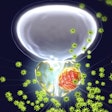
Researchers have devised an artificial intelligence (AI) model to develop potential new antibiotics which chemists can synthesize in the lab.
The model, SyntheMol, was developed by scientists at Stanford Medicine and McMaster University.
It created structures and chemical recipes for six novel drugs aimed at killing resistant strains of Acinetobacter baumannii, a pathogen responsible for deaths related to antibacterial resistance.
A report in Nature Machine Intelligence describes SyntheMol and how it was validated.
Scientists are urgently seeking new ways to combat antibiotic resistance, but while AI methods can discover new antibiotics, existing methods have notable limitations. Generative AI has the ability to "hallucinate" or formulate entirely new responses; however, previous attempts to generate new drugs with this method have created compounds that would be impossible to make in real world laboratories.
“Our hypothesis was that there are a lot of potential molecules out there that could be effective drugs, but we haven’t made or tested them yet,” James Zou, who is an associate professor of biomedical data science at Stanford and a senior co-author of the study, said in a Stanford Medicine News Center report.
SyntheMol is a generative model that designs new compounds which are easy to synthesize. The model was trained to construct potential drugs using a library of more than 130,000 molecular building blocks and a set of validated chemical reactions. It generates not only final compounds but also the steps it takes with those building blocks, giving the researchers a set of recipes to produce the drugs.
The team applied SyntheMol to design molecules that inhibit the growth of A. baumannii, a burdensome Gram-negative bacterial pathogen. They worked with the Ukrainian chemical company Enamine to efficiently generate 58 compounds, six of which killed a resistant strain of A. baumannii when researchers tested them in the lab. The compounds also showed antibacterial activity against several other phylogenetically diverse bacterial pathogens.
The scientists were able to further test two of the six compounds for toxicity in mice, and plan to test the drugs in mice infected with A. baumannii to see if they work in a living body.
The six compounds differ substantially from each other and existing antibiotics. While it is not known how their antibacterial properties work at the molecular level, exploring those details could yield general principles relevant to other antibiotic development.
“This AI is really designing and teaching us about this entirely new part of the chemical space that humans just haven’t explored before,” Zou said.
The study was funded by the Weston Family Foundation, the David Braley Centre for Antibiotic Discovery, the Canadian Institutes of Health Research, M. and M. Heersink, the Chan-Zuckerberg Biohub, and the Knight-Hennessy scholarship.



















